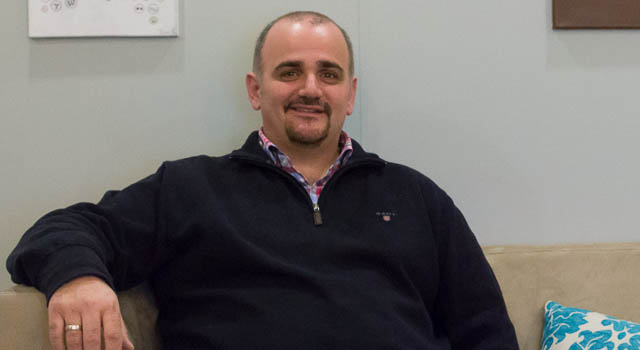
DStv Online CEO John Kotsaftis, 41, is the quintessential geek. He tells me as much when I sit down to interview him in one of the boardrooms at DStv Online’s offices in Randburg, Johannesburg.
His love of technology started with a friend’s gaming console. “He got an Atari and I was so excited I didn’t sleep that night.”
Kotsaftis’s first computer was a Commodore 64, which he began programming when he was just 11.
Married with a two-year-old daughter and with a second child due in September, he is also a big music fan (especially when it comes to Greek music) and a keen basketball player. “There’s a group of us in our 40s who play at the Greek club on Saturdays. It’s my version of golf.”
Kotsaftis also considers his obsession with technology a hobby. “I’m a gadget freak to the point of insanity. I’ve bought a lot of stuff on Kickstarter. Sometimes I lose money backing stupid projects.”
The DStv Online boss describes himself as a “proudly South African Greek”. Though both his parents hail from Athens, Kotsaftis was born in Cape Town.
It was while studying at the University of Cape Town — towards a BCom in information systems — that Kotsaftis encountered someone on campus using terminal-based computer chat to talk to another person in Germany. “I knew then that the Internet was the thing to get into.”
Kotsaftis went on to do a postgraduate degree at Rhodes. At the time, the Eastern Cape university had South Africa’s only Internet connection.
“Two weeks before I started at Rhodes, Marc Andreessen had launched Mosaic, the first Web browser. So, we started building HTML pages and when I graduated a year later, no one had even seen the things we’d been playing with.”
London calling
Kotsaftis went on to jobs at Accenture and Shell, where he worked in business intelligence and research and development. He eventually moved to London with Shell, just in time to see the dot-com bubble burst.
“There was a lot of activity around start-ups in London at the time, and I figured I should become an Internet entrepreneur,” Kotsaftis says.
“At the time you had to have your own limited company to get tax breaks. That meant you needed to do tax returns, full accounts and so on. Agencies would do it for you for a small fee, but they were basically just inputting your data, and that meant there were sometimes errors.”
Kotsaftis decided he should create an online solution where people could input their own data. “Essentially, I invented cloud-based accounting software, though no one talked in terms of ‘the cloud’ then,” he says in jest.
The product was called easycounting.com, and Kotsaftis later sold it to an accounting services aggregation firm called Numerica before returning to South Africa, utterly determined not to go and work for a big company.
While looking about for a new project, Kotsaftis learnt about Internet service provider MWeb’s iZone incubator, which hired entrepreneurs, provided them with capital, and let them “build stuff”.
Antonie Roux, the late Naspers executive who helped build the media group’s global Internet business, was heading the project at the time. The iZone model proved “too loose” and was discontinued. Kotsaftis was asked to take on the role of chief technology officer of Naspers’s growing Internet operations business.
At the time, Naspers had only MWeb and China’s Tencent — which became arguably the group’s best ever investment — in its Internet portfolio. “The company had lost money in China and Indonesia trying to launch MWeb there and had invested in Tencent to the tune of US$37m.”
Around 2004, Naspers was keen to enter the Indian market and had consolidated its various MWeb portals under the 24.com banner. Kotsaftis looked after blogging, photo sharing and similar products, including a social network that was never launched, Internet video services and online gaming.
Because it was proving too expensive to buy companies in India, Naspers decided to launch its own Internet business there from scratch.
Kotsaftis headed up the group’s “strategic worldwide applications and technologies” (Swat) business, which became the engine of its online growth. It hired the former head of Google India, Ashish Kashyap, to lead its new social media platform, Ibibo.
Though none of the South African products proved successful in India, Kotsaftis believes the move allowed Naspers to “make a lot of noise” in the region.

“It also got me thinking about the idea of the ‘lean start-up’, which became a thread I followed thereafter.”
Kotsaftis says the experience taught him it wasn’t necessary to have an elaborate business plan but one could instead simply “start doing stuff and iterate from there”. He says that, combined with working with great talent, makes the “secret sauce” in launching new businesses.
Next, Kotsaftis found himself tasked with chasing mergers and acquisitions for Naspers, reporting directly to Antonie Roux. “I travelled the world as part of the Naspers team that bought Internet companies. The questions I had to ask each time were: is the strategy right, does the tech look good, are the people right, and are the products good?”
This gave him the opportunity to “look into the guts” of a large number of Internet companies. He was subsequently sent to Brazil to start an Internet business called Brazigo, which later became part of Naspers’s print venture in the South American market, called Abril.
“Being an entrepreneur, I thought I wouldn’t last long with Naspers,” Kotsaftis says. “But they give you so much leeway to do things that it’s a wild ride.”
‘Competition is coming’
It was a visit by Roux to Kotsaftis’s home that prompted his next big transition at Naspers. “Antonie came to see what I’d done at my house. I was running MythTV servers, ripping content off the Internet, and playing it back on a big television and sound system. At the time, [streaming service] Hulu had been launched and there was talk that the Internet would cannibalise the pay-TV market, where Naspers dominates the South African market through its MultiChoice subsidiary, which owns DStv.
“MultiChoice had five new-media divisions at the time looking at this possibility, but it was all very fragmented,” Kotsaftis says. Roux wanted someone who understood the dynamics of the Internet to tidy things up and help the company focus its efforts.
DStv Online became the division that amalgamated each of MultiChoice’s new-media divisions. “We had to rip the guts out and replace the management team over time,” Kotsaftis says.
Under Kotsaftis, DStv Online overhauled the DStv and SuperSport websites, took over all digital content for MultiChoice, and built products such as its on-demand (BoxOffice) and catch-up services.
“BoxOffice changed the whole DNA of DStv because we went from being a linear subscription-based business to more of a [mobile network operator] handling small transactions on a real-time basis.”
Kotsaftis also led a project to build what he calls the only user experience laboratory for television in the southern hemisphere.
“We have eyeball trackers and other monitoring equipment to see how people react to different products, from watching TV to interacting with our websites or apps.”
MultiChoice has also become more experimental, he says.
“We started a music business called O Music, and a gaming one called O Games. We also built fantasy team games for SuperSport. Not all of them worked and when they didn’t we killed them fast and moved on. ‘Execute fast. Fail fast.’ That’s the new mantra here.”
In order to find new talent for DStv Online, Kotsaftis works closely with South Africa’s universities. Naspers funds postgraduate engineering and computer science students doing research in new media, and sponsors the MIH Media Lab at Stellenbosch University.
Kotsaftis says it’s important for companies, new or old, to realise that “competition is coming”, and not simply from traditional competitors. “With ubiquitous broadband, competition will come from everywhere, from players we don’t understand yet.” — (c) 2013 NewsCentral Media




